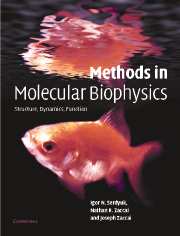Book contents
- Frontmatter
- Contents
- Foreword by D. M. Engelman
- Foreword by Pierre Joliot
- Preface
- Introduction: Molecular biophysics at the beginning of the twenty-first century: from ensemble measurements to single-molecule detection
- Part A Biological macromolecules and physical tools
- Part B Mass spectrometry
- Part C Thermodynamics
- Part D Hydrodynamics
- Part E Optical spectroscopy
- Chapter E1 Visible and IR absorption spectroscopy
- Chapter E2 Two-dimensional IR spectroscopy
- Chapter E3 Raman scattering spectroscopy
- Chapter E4 Optical activity
- Part F Optical microscopy
- Part G X-ray and neutron diffraction
- Part H Electron diffraction
- Part I Molecular dynamics
- Part J Nuclear magnetic resonance
- References
- Index of eminent scientists
- Subject Index
- References
Chapter E4 - Optical activity
from Part E - Optical spectroscopy
Published online by Cambridge University Press: 05 November 2012
- Frontmatter
- Contents
- Foreword by D. M. Engelman
- Foreword by Pierre Joliot
- Preface
- Introduction: Molecular biophysics at the beginning of the twenty-first century: from ensemble measurements to single-molecule detection
- Part A Biological macromolecules and physical tools
- Part B Mass spectrometry
- Part C Thermodynamics
- Part D Hydrodynamics
- Part E Optical spectroscopy
- Chapter E1 Visible and IR absorption spectroscopy
- Chapter E2 Two-dimensional IR spectroscopy
- Chapter E3 Raman scattering spectroscopy
- Chapter E4 Optical activity
- Part F Optical microscopy
- Part G X-ray and neutron diffraction
- Part H Electron diffraction
- Part I Molecular dynamics
- Part J Nuclear magnetic resonance
- References
- Index of eminent scientists
- Subject Index
- References
Summary
Historical review and introduction to biological problems
Optical activity is the property of certain materials to change the angle of polarization of a beam of light that is shone through them as a function of its wavelength (optical rotation dispersion, ORD), or to absorb light differently according to its wavelength and polarization (circular dichroism, CD, from the Greek related to two colours).
1812–1838
Jean-Baptiste Biot and Auguste Fresnel independently made careful studies of optical activity. Biot'spolarimeter (an optical instrument used to measure the angle of rotation of polarised light) used sunlight, plane-polarised by reflection off glass, as a light source. Biot defined [α] the angle of specific rotation of the axis of plane-polarised light by an optically active solution in terms of the concentration in grams per cubic centimetre and the optical path in decimetres, a definition still in use. In 1824, Fresnel predicted that helical structures would be optically active.
1848
Louis Pasteur observed that optically inactive crystals of sodium ammonium tartrate were in fact mixtures of two classes. When separated, both classes turned out to be optically active with respective specific rotation angles of equal value but opposite in sign. The molecules making up the crystals were themselves in one of two asymmetric forms, enantiomorphs (from the Greek for opposite shapes), each a mirror image of the other. Since a two-dimensional molecule and its mirror image can be made to coincide and considered to be identical, the implication was that molecules are three-dimensional (Comment E4.1).
- Type
- Chapter
- Information
- Methods in Molecular BiophysicsStructure, Dynamics, Function, pp. 601 - 624Publisher: Cambridge University PressPrint publication year: 2007
References
- 1
- Cited by



